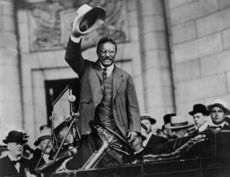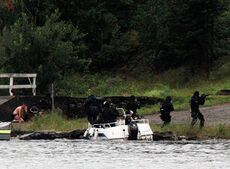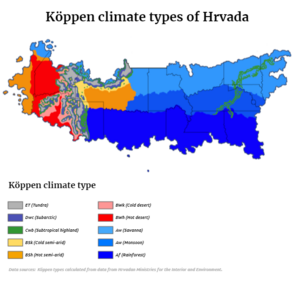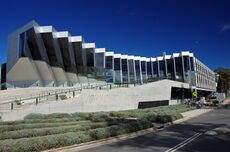Hrvada: Difference between revisions
No edit summary |
No edit summary |
||
| Line 225: | Line 225: | ||
[[File:Tvrtko Biklos 1.jpg|thumb|upright|[[Tvrtko Biklos]] rallying his supporters during the [[1901 Hrvadan General Election|Red June]]]] | [[File:Tvrtko Biklos 1.jpg|thumb|upright|[[Tvrtko Biklos]] rallying his supporters during the [[1901 Hrvadan General Election|Red June]]]] | ||
Social unrest and discontent with elite industrialists led to rise of populist, anarchist, socialist, and labor organizations who focused on reforming or even revolting against the Hrvadan economic system. [[Social Democratic Party of Hrvada|Social Democratic]] politician [[Tvrtko Biklos]] channeled this anger among the common people and used it to be elected to the office of [[Prime Minister of Hrvada|Prime Minister]] in [[1901 Hrvadan General Election|1901]], historians refer to this election as "Red June." As Prime Minister, Biklos passed a series of progressive reforms including; the establishment of five new ministries ([[Ministry for Education (Hrvada)|Education]], [[Ministry for the Environment (Hrvada)|Environment]], [[Ministry for Health (Hrvada)|Health]], [[Ministry for the Interior (Hrvada)|Interior]], and [[Ministry for Labor (Hrvada)|Labor]]), regulation of the quality of food and drugs, worker safety legislation, the formation of Hrvada's [[List of national parks of Hrvada|National Parks]], the establishment of the [[Hrvadan Central Bank]], the levying of a federal tax on income, the implementation of the Hrvadan [[Social Security in Hrvada|Social Security]] system. | Social unrest and discontent with elite industrialists led to rise of populist, anarchist, socialist, and labor organizations who focused on reforming or even revolting against the Hrvadan economic system. [[Social Democratic Party of Hrvada|Social Democratic]] politician [[Tvrtko Biklos]] channeled this anger among the common people and used it to be elected to the office of [[Prime Minister of Hrvada|Prime Minister]] in [[1901 Hrvadan General Election|1901]], historians refer to this election as "Red June." As Prime Minister, Biklos passed a series of progressive reforms including; the establishment of five new ministries ([[Ministry for Education (Hrvada)|Education]], [[Ministry for the Environment (Hrvada)|Environment]], [[Ministry for Health (Hrvada)|Health]], [[Ministry for the Interior (Hrvada)|Interior]], and [[Ministry for Labor (Hrvada)|Labor]]), regulation of the quality of food and drugs, worker safety legislation, the formation of Hrvada's [[List of national parks of Hrvada|National Parks]], the establishment of the [[Hrvadan Central Bank]], the levying of a federal tax on income, the implementation of the Hrvadan [[Social Security in Hrvada|Social Security]] system, and the establishment of healthcare programs for the poor and elderly ([[Medicare in Hrvada|Medicare]] and [[Medicaid in Hrvada|Medicaid]]). | ||
Following a 15 year reign as Prime Minister, Biklos finally stepped down in 1916. Thanks to a forty-year period of growth and general stability during the period after the Biklos premiership, this time in Hrvadan history is known as the [[Hrvadan Era of Good Feelings|era of Good Feelings]]. | Following a 15 year reign as Prime Minister, Biklos finally stepped down in 1916. Thanks to a forty-year period of growth and general stability during the period after the Biklos premiership, this time in Hrvadan history is known as the [[Hrvadan Era of Good Feelings|era of Good Feelings]]. | ||
| Line 268: | Line 268: | ||
''Main articles: [[Flora of Hrvada]], [[Fauna of Hrvada]]'' | ''Main articles: [[Flora of Hrvada]], [[Fauna of Hrvada]]'' | ||
[[File:Public Doman Alligator 1.png|thumb|upright|left|An alligator in the [[Juzetarska River|Juzetarska River]] delta]] | |||
The Hrivada is 17 megadiverse countries containing a large amount of endemic species: about 54,000 species of vascular plants occur in the Hrvadan Federation. Hrvada is home to more than 500 mammal species, more than 1800 bird species, 632 reptile species, and 1019 amphibian species, as well as about 69,000 insect species. | |||
There are 44 [[List of national parks of Hrvada|national parks]] and hundreds of other federally managed parks, forests, and wilderness areas. Altogether, the government owns about 33% of the country's land area, mostly in the western states. Most of this land is protected, though some is leased for oil and gas drilling, mining, logging, or cattle ranching, and about .86% is used for military purposes. | |||
Environmental issues include debates on oil and nuclear energy, dealing with air and water pollution, the economic costs of protecting wildlife, logging and deforestation, and climate change. The most prominent environmental agency is the [[Ministry for the Environment (Hrvada)|Ministry for the Environment]], created under the leadership of [[Prime Minister of Hrvada|Prime Minister]] [[Tvrtko Biklos]] in 1903. | |||
==Demographics== | ==Demographics== | ||
| Line 296: | Line 304: | ||
''Main article: [[Religion in Hrvada]]'' | ''Main article: [[Religion in Hrvada]]'' | ||
[[File:Sveti Josip National Cathedral 1.jpeg|thumb|upright|[[Saint Josip's National Cathedral]] in [[Hrvadagrad]]]] | |||
Although [[Attancian Catholicism]] is recognized as the state religion of Hrvada, the [[Hrvadan Charter of Freedoms]] guarantees the free exercise of religion within the country. | Although [[Attancian Catholicism]] is recognized as the state religion of Hrvada, the [[Hrvadan Charter of Freedoms]] guarantees the free exercise of religion within the country. | ||
| Line 302: | Line 312: | ||
Although a large majority of Hrvadans claim that religion plays a significant role in their lives, this is especially true in [[Southern Hrvada|Southern]] and [[Hrvadan Midwest|Midwestern]] Hrvada which are collectively known as the [[Hrvadan Bible Range]]. | Although a large majority of Hrvadans claim that religion plays a significant role in their lives, this is especially true in [[Southern Hrvada|Southern]] and [[Hrvadan Midwest|Midwestern]] Hrvada which are collectively known as the [[Hrvadan Bible Range]]. | ||
[[Saint Josip]] is recognized as the patron saint of Hrvada. | |||
===Health=== | ===Health=== | ||
[[File:Hospital in Hrvadagrad 1.jpg|thumb|upright|left|A hospital in [[Hrvadagrad]]]] | |||
''See also: [[Health care in Hrvada]]'' | ''See also: [[Health care in Hrvada]]'' | ||
The [[Ministry for Health (Hrvada)|Ministry for Health]] reported that the Hrvadan Federation had an average life expectancy at birth of 76.2 years in 2020 (74.5 years for men and 78.1 years for women), up 0.1 year from 2019. This was the second year that overall Hrvadan life expectancy rose slightly after three years of overall declines that followed decades of continuous improvement. The recent decline, primarily among the age group 25 to 64, was largely due to record highs in the drug overdose and suicide rates; the country still has one of the highest suicide rates among wealthy countries. From 1999 to 2020, more than 508,200 [[Hrvadans]] died from drug overdoses. Life expectancy was highest among the small population of [[Furbishmen|Furbish-Hrvadans]] and lowest among [[Black Hrvadans]]. | |||
Government-funded health care coverage for the poor ([[Medicaid in Hrvada|Medicaid]]) and for those age 70 and older ([[Medicare in Hrvada|Medicare]]) is available to Hrvadans who meet the programs' income or age qualifications. Nonetheless, the Hrvada remains the only developed nation without a system of universal health care although many politicians have made promises to change this. In 2017, 14.4% of the population did not carry health insurance. | |||
===Education=== | ===Education=== | ||
''Main article: [[Education in Hrvada]]'' | ''Main article: [[Education in Hrvada]]'' | ||
[[File:Hrvadan National University 1.jpg|thumb|upright|[[Hrvadan National University]] in [[Hrvadagrad]]]] | |||
Hrvadan public education is operated by state and local governments and regulated by the Hrvadan [[Ministry for Education (Hrvada)|Ministry for Education]]. Children are required to attend school from the age of five or six (beginning with kindergarten or first grade) until they turn 18 (generally bringing them through twelfth grade, the end of high school); although under some circumstances students are able to leave school at 16 or 17. | |||
About 21% of children are enrolled in parochial or nonsectarian private schools. Just over 3% of children are homeschooled. The Hrvadan Federation spends an average of ₭11,514 per year on public elementary and secondary school students in the 2019–2020 school year. Some 70% of Hrvadan college students attend public universities. Of Hrvadans 25 and older, 82.5% graduated from high school, 49.5% attended some college, 22.1% earned a bachelor's degree, and 7.1% earned graduate degrees. The basic literacy rate is approximately 98%. | |||
The Hrvadan Federation has many private and public institutions of higher education. Many of the world's top universities, as listed by various ranking organizations, are in Hrvada. There are also local community colleges with generally more open admission policies, shorter academic programs, and lower tuition. | |||
==Government and politics== | ==Government and politics== | ||
Revision as of 16:49, 2 July 2021
Hrvadan Federation Federacija Hrvada | |
|---|---|
| Motto: "Bog, Obitelj, i Nacija" Fluvan: "God, Family, and Nation" | |
| Anthem: Moja Domovina, Daleko ("My Homeland, Far Away") | |
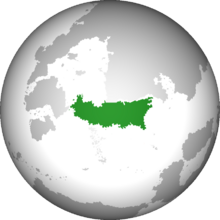 Location of Hrvada (dark green) | |
| Capital | Hrvadagrad |
| Largest | Imperia |
| Official languages | Hrvadan |
| Ethnic groups (2020) |
|
| Religion (2020) |
|
| Demonym(s) | Hrvadans |
| Government | Federal semi-parliamentary republic |
| Danijel Rukavina | |
| Elizabeta Stjepanić | |
| Legislature | Sabor |
| Establishment | |
• Empire | 27 BC |
| 1 March 476 | |
| 25 December 1863 | |
| 9 April 1865 | |
| Area | |
• Total | 5,501,285 km2 (2,124,058 sq mi) |
| Population | |
• 2020 census | 232,267,728 |
• Density | 109/km2 (282.3/sq mi) |
| GDP (nominal) | estimate |
• Total | ₭11.773 trillion |
• Per capita | ₭55,426 |
| Gini (2020) | 34.0 medium |
| HDI (2020) | 0.938 very high |
| Currency | Hrvadan kuna (₭) (HFK) |
| Date format | dd.mm.yyyy |
| Driving side | right |
| Calling code | +1 |
| Internet TLD | .hr |
Hrvada, officially the Hrvadan Federation is a large country located on the continent of Ita. It consists of 14 provinces and one federal territory. At 5,501,285 square kilometers (2,124,058 square miles), it is the world's #th largest country by total area. With a population of more than 232 million people, it is the third most populous country in the world. The national capital is Hrvadagrad and the largest city is Imperia.
Etymology
Main article: Names of Hrvadans and Hrvada
The name of Hrvada derives from the name of the Hrva people. It is a general consensus among historians, etymologists, and researchers that the word "Hrva" means "old Poyoinens" and the suffix da is a corruption of the Hrvadan word "de" meaning "promise." Thus "Hrvada" loosely translates to "promise of the old Poyoinens." There is great debate regarding what this exactly means, but the leading theory has to do with a Hrva folk deity promising to deliver the modern-day country to the Hrva people.
History
Main articles: History of Hrvada and Outline of Hrvadan history
Paleolithic era and Hrva settlement
Thanks to evidence of paleolithic technology found in cave sites near Bijehrast, Pustinja, it is generally accepted by historians and other researchers that Homo sapiens first started inhabiting modern-day Hrvada between 80,000 and 170,000 years ago. These original inhabitants of Hrvada were known to be dark skinned thanks to the country's location along the equator and maintained a nomadic hunter-gatherer lifestyle. Today, around 9% of Hrvadans can trace their ethnicity back to the original paleolithic inhabitants.
Hrva people began migrating south from the continent of Poyoinen at least 15,000 years ago; however, some evidence suggests an even earlier date of arrival. By 14,000 BC, a massive influx Hrva migrants violently murdered or enslaved the original paleolithic inhabitants. Over time the Hrva population grew increasingly complex developing advanced agriculture, architecture, and complex social and cultural traditions. Unlike their predecessors the Hrva had lighter skin and eventually maintained a sedentary lifestyle, founding major settlements like Diguskia near modern-day Sveti Josip, Kanui which is one of the first and most complex Hrva archaeological sites in modern-day Hrvada. Today, around 85% of Hrvadans can trace their ethnicity back to the Hrva settlers.
Early Hrvadan Empire, ministry of Isus, and Jewish diaspora
Main article: Hrvadan Empire
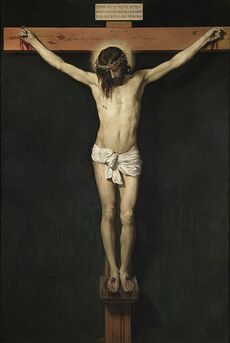
By 27 BC, Hrva people had already settled the entirety of modern-day Hrvada and united it under the banner of the autocratic Hrvadan Empire, led at that time by Emperor Dioklecijan who managed the country from his seat of power in Hrvadagrad. During this era, the Hrvadan underclass congregated in major cities and made a living as soldiers or laborers. Wealthier Hrvadans mostly lived on large plantations in rural areas where they managed major agricultural operations specializing in mainly rice, beans, coffee, and tobacco crops grown and harvested almost exclusively by Black Hrvadan slaves. With the exception of a notable Jewish population in the northeastern part of Hrvada dating back to at least 2000 BC, the majority Hrvadans adhered to Hrvadan folk religion.
According to the consensus of most historians; in 4 BC, Jewish preacher and central figure in Christianity, Isus Christ, was born in the city of Betlehem, Uljeska. According to the Christian gospels, after his baptism in the Vojnik River, Isus started his ministry across the mainly Jewish parts of Hrvada. Along with his twelve appointed apostles, he preached and administered miracles around his home region of Uljeska and then later in and around the at the time largely Jewish city of Imperia where he was ultimately rejected and crucified in 33 AD. After the crucifixion, Petar one of the twelve apostles, left Hrvada to preach Christianity and establish the seat of the Christian church in Attancia.
In 45 AD, inspired by what he claimed was "vision from the Jewish God" instructing him to "punish the Jews for rejecting the Son of God," Hrvadan Emperor Hadrijane marched northeast along with thirteen legions with the goal of the complete eradication of Judaism in Hrvada. When he reached Imperia he prohibited the adherence of Torah law in the city, installed a statue of himself in the Jewish Temple sanctuary, burned the sacred scrolls of Judaism that were stored in the Temple, and executed Jewish scholars. Overall as a consequence of this event; practice of Judaism was prohibited in Hrvada, over 500,000 Hrvadan Jews were exterminated, and the massive death and destruction led to the Jewish diaspora.
Late Hrvadan Empire
Main article: Black March
In 306 AD Konstantine was coronated Emperor of Hrvada. In addition to enacting administrative, financial, social and military reforms to strengthen the empire, Konstantine was also known for being the first Christian leader of Hrvada. His reign yielded the adoption of Christianity as the official religion of Hrvada as well as the construction of the Church of the Resurrection on the purported site of Isus' tomb in Imperia, greatly accelerating the conversion of the Hrvadan people from the ancient folk religion to Christianity. According to the consensus of most historians, the Hrvadan Empire reached its apex under Konstantine.
Concerned with the apparent decline of the Hrvadan Empire's military and economic strength, a breakdown in social order and cohesion, rampant degeneracy, and the throne's attempts to abolish slavery; on 1 March 476 a group of twelve affluent Hrvadans known as the Grand Council marched into Hrvadagrad along with an army consisting of 100,000 people, meeting little resistance. As a response to this, Emperor Romul abdicated the throne and ceded power to the Council, beginning the Hrvadan Oligarchy era.
Oligarchy and antebellum eras
Main article: Antebellum Hrvada
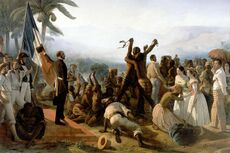
From the 476 Black March coup to the start of the Hrvadan Civil War in 1859, the Oligarchy era spanned a period of major development, reform, and stability in Hrvada under the leadership of the Grand Council. On 17 July 1191 the Council officially divided the country into 14 provinces, granting each limited self-governmental powers (including the power to levy taxes). On 29 July 1776, the Grand Council ratified the Hrvadan Charter of Freedoms which expanded the civil rights and individual liberties afforded to the Hrvadan citizenry.
Nearing the end of the Oligarchy era, the council passed a series of reforms that some argue led to the Hrvadan Civil War. Most historians consider this period of time to be Hrvada's antebellum era. On 2 January 1807, in a complete reversal of its pro-slavery position leading up to and during the 476 Black March coup, the Grand Council issued a historic proclamation emancipating all enslaved peoples within the borders of Hrvada as well as prohibiting the sale of slaves at Hrvadan ports. In 1845 the Grand Council levied Hrvada's first ever tax on the national level, a 1% tax on the sale of all goods and services within Hrvada in order to pay for the construction of the Transcontinential Railroad which would eventually connect Imperia to Sveti Franjo. These actions angered many Hrvadans, especially business owners and slave owners in the southern provinces, and initiated the debate regarding the Grand Council's absolute power as well as provincial rights that ultimately led to the Civil War.
Civil War and Reconstruction eras
Main articles: Hrvadan Civil War, Treaty of Alexandria, Reconstruction Council
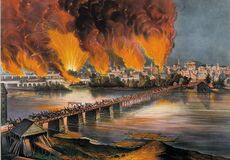
Sectional conflict regarding political representation, provincial rights, and economic disparities between the industrial north and agricultural south ultimately led to the Hrvadan Civil War. Between 3 August and 5 October 1859, five southern provinces (Cvijecia, Juzetarska, Pijemont, Prijat, and Velrika) seceded from the rest of the country to form Federalist Hrvada; while the central government, known as Council Hrvania, maintained that such actions were illegal.
The first shots of the Civil War were fired on 11 October 1859 near Prolaz, Prijat when Federalist militiamen successfully took over an isolated Council outpost that refused to transfer control to the newly formed Federalist government. Other notable battles and campaigns during the Civil War include: the Battle of Ferfaks on 1 December 1859 when Council troops took control over the city of Ferfaks, Pijemont creating a buffer between the Council capital city of Hrvadagrad and the Federalist army. Stošija's March to the Lakes between February 1860 and March 1861 when Federalist General Denis Stošija marched his army from Kraljev, Pijemont to Ravno, Prerija wrecking havoc across the Council-controlled province of Prerija and cutting Council Hrvada into two separate parts. Darko's Mountain Campaign between January 1861 and November 1861 where Council General Gabrijel Darko halted Federalist efforts to march west into the Council-controlled province of Pustinja while outnumbered and under-supplied. And the Battle of Vukovar on 4 April 1863 where Council troops failed to capture the strategic port city of Vukovar, Juzetarska and set up a foothold on the Juzetarska River.
By late 1863, citing high casualties on both sides as well as a stalemate on all fronts; both sides agreed to the Treaty of Alexandria which mandated a white peace as well as the formation of a Reconstruction Council made up of both Council and Federalist representatives who would be tasked with creating a compromise form of government for Hrvada.
The Hrvadan Reconstruction Council convened following the Treaty of Alexandria on 25 December 1863. Members of the reconstruction council included Federalist Prime Minister Davor Josip, Federalist General Denis Stošija, Council Hrvada representative Aljoša Lončar, and others. After more than a year of deliberations on 9 April 1865, the reconstruction council ratified the Constitution of Hrvada. The new "compromise constitution" preserved the Grand Council which Federalists saw as "oligarchic" and "undemocratic", created the democratically elected Sabor which could put checks on the Grand Council, and vastly increased provincial autonomy.
Gold rush, War of 1870, and Gilded age
Main articles: Hrvadan Gold Rush, Hrvadan-Furbish War of 1870, Hrvadan Gilded Age

In 1868, precious metals were discovered in Western Hrvada leading to the Hrvadan Gold Rush, this event spurred a massive influx of migration to the western provinces. In mid-1869, ninety-seven Furbish pirates raided the port of Vukovar, Juzetarska in an attempt to steal a barge laded with gold shipped east from the Stjenjak Mountains. The plot was thwarted by the Hrvadan Coast Guard and the instigators were found guilty of piracy and sentenced to death by a Hrvadan court.
In-response to such action, the Furbish government sent a strongly worded letter to Hrvada demanding the immediate release of the pirates who were Furbish citizens; the Hrvadan government replied by insulting the Furbish Islands by comparing the country to the Tower of Babel. In early-1870, the Furbish Islands declared war and successfully captured Vukovar using a small naval fleet and a group of marines led by Gabriël Van Aarle, freeing the Furbish pirates who were held in a prison in the city. The Furbish invaders were eventually pushed back by a detachment of the Hrvadan Army led by Mjaor General Andrija Hikori before they could move farther inland and were forced to evacuate the city, ending the war. Although the Hrvadan-Furbish War of 1870 was considered a tactical victory for the Furbish Islands due to their successful evacuation of its citizens, Hrvada's strategic victory in the war is seen as one of the most important post-civil War unifiers. After this incident, Hrvadan-Furbish relations would remain damaged for more than ninety years.
In 1880, Andrija Hikori was elected Prime Minister of Hrvada due to his status as a hero in the War of 1870. Hikori's premiership oversaw a period of increased urbanization and an influx of immigration from countries such as Attancia and Logar which supplied much needed labor for industrialization and drove a transformation of Hrvadan culture. Infrastructure and inventions such as telegraph lines and transcontinential railroads spurred economic growth, increased communication, and the the rise of super-wealthy industrialists.
Red June and the era of Good Feelings
Main articles: Red June, Hrvadan Era of Good Feelings
Social unrest and discontent with elite industrialists led to rise of populist, anarchist, socialist, and labor organizations who focused on reforming or even revolting against the Hrvadan economic system. Social Democratic politician Tvrtko Biklos channeled this anger among the common people and used it to be elected to the office of Prime Minister in 1901, historians refer to this election as "Red June." As Prime Minister, Biklos passed a series of progressive reforms including; the establishment of five new ministries (Education, Environment, Health, Interior, and Labor), regulation of the quality of food and drugs, worker safety legislation, the formation of Hrvada's National Parks, the establishment of the Hrvadan Central Bank, the levying of a federal tax on income, the implementation of the Hrvadan Social Security system, and the establishment of healthcare programs for the poor and elderly (Medicare and Medicaid).
Following a 15 year reign as Prime Minister, Biklos finally stepped down in 1916. Thanks to a forty-year period of growth and general stability during the period after the Biklos premiership, this time in Hrvadan history is known as the era of Good Feelings.
Civil rights and Nižić eras
Main articles: Hrvadan Civil Rights Era, Ratimir Nižić
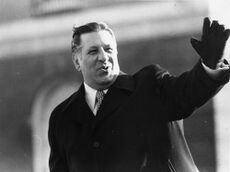
Following the emancipation of Hrvada's slaves in 1807, Black Hrvadans continued to face widespread racism and discrimination across the country. In 1956, seeking civil rights and an end to racism, groups of Blacks instigated large-scale protests. This movement of civil rights protesters marked the end of the era of Good Feelings. In the summer of 1957, the civil rights movement took a violent turn as non-violent protests escalated to rioting and looting. Responses to this Long Hot Summer varied; in Vjetragrad, Prerija, mayor Nikola Dalibor Sr. implemented a city-wide curfew order and instructed the Vjetragrad Police Department to shoot anyone breaking the order on-sight. In Vjetragrad alone, 122 people were killed and thousands were injured.
Running on a moderate platform promising both law-and-order and limited civil rights legislation, Republican politician Ratimir Nižić was elected Prime Minister in 1958. Nižić oversaw the passage of sweeping voting rights, anti-discrimination, and anti-poverty legislation while subsequently supporting an anti-riot bill and the arrest of major civil rights leaders on charges ranging from misdemeanor vandalism to sedition.
Throughout the 1960's, Prime Minister Nižić pursued a policy if increasing Hrvada's cooperation with other nations across the globe. In 1964, Nižić became the first Hrvadan Prime Minister since the Hrvadan-Furbish War of 1870 to conduct a state-visit to the Furbish Islands. During this visit, Nižić visited with multiple Furbish leaders, toured landmarks in the Furbish Islands, and ultimately agreed to reset Hrvadan-Furbish relations. Nižić's visit to the Furbish Islands fostered partnership and completely repaired relations between the two countries.
Contemporary history
The end of the premiership of Ratimir Nižić marked another sustained era of political and economic stability in Hrvada. This however changed in 1989 during the Panic of 1989 when the Imperia Stock Exchange melted down and lost 33% of it's value in less than an hour. Although the markets surged 19% the next day thanks to an influx of cash from weathy investors, hedge funds, and the Hrvadan Central Bank; the effort was not enough to avoid a recession that put millions out of work and decreased GDP by 8%. The Hrvadan economy wouldn't start growing again until 1992 and wouldn't reach pre-panic of 1989 levels until the year 2000.
Starting in the mid-2000's, mass illegal migration from countries like Kevoria among other issues would spark the gradual rise of far-right political movements including the Confederation Party and the terrorist group known as the Ustaše - Hrvadan Revolutionary Movement (U-HRP) which in 2011 was behind the killing of over 78 people (including 69 children) at a camp for Dodoian expats living in Hrvada.
On the night of 31 May 2021, the PH Endeavor oil rig exploded, killing 67 people and leaking over 60,000 barrels of oil a day into Hrvadan waters. The PH Endeavor disaster was one of the worst modern environmental disaster in Hrvada and took over a month to clean up.
In the 2021 Hrvadan General Election the Confederation became the largest political party in the Sabor — the first time a political party other than the Republicans, Social Democratcs, Liberals managed to achieve the distinction — marking one of the biggest political upsets in Hrvadan history.
Geography
Main article: Geography of Hrvada
The 14 provinces and the Hrvadan Capital Territory occupy a combined area of 5,501,285 square kilometers (2,124,058 square miles).
The rainforests of southeastern Hrvada gradually give way further north to the grasslands and savannahs of the flat and fertile Midwestern Plains which stretch west from the Krošnja Mountains and occupy much of the Midwest. The Krošnjas separate the Midwest from eastern seaboard. The Juzetarska-Kanui River, Hrvada's longest river system, runs through the heart of the country. Significant settlements in this part of Hrvada include the country's largest city and main finance center Imperia, Vjetragrad, petroleum and natural gas powerhouse Dugrad, Philadelphia, and the country's capital Hrvadagrad.
West of the Midwestern Plains are the Stjenjak Mountains which extend north and south across the country, peaking around # meters (# feet). Farther west are deserts such as the Sunce and the Vega. At an elevation of # meters (# feet), Srebro's Mount Otkupitelj is the highest peak in the country. Significant settlements in this part of Hrvada include the country's entertainment capital Andeli, mining powerhouse Feniks, Sveti Ivan, technology and innovation center Sveti Franjo, and Kraljevgrad.
Flora and fauna
Main articles: Flora of Hrvada, Fauna of Hrvada
The Hrivada is 17 megadiverse countries containing a large amount of endemic species: about 54,000 species of vascular plants occur in the Hrvadan Federation. Hrvada is home to more than 500 mammal species, more than 1800 bird species, 632 reptile species, and 1019 amphibian species, as well as about 69,000 insect species.
There are 44 national parks and hundreds of other federally managed parks, forests, and wilderness areas. Altogether, the government owns about 33% of the country's land area, mostly in the western states. Most of this land is protected, though some is leased for oil and gas drilling, mining, logging, or cattle ranching, and about .86% is used for military purposes.
Environmental issues include debates on oil and nuclear energy, dealing with air and water pollution, the economic costs of protecting wildlife, logging and deforestation, and climate change. The most prominent environmental agency is the Ministry for the Environment, created under the leadership of Prime Minister Tvrtko Biklos in 1903.
Demographics
Main articles: Hrvadans, Demographics of Hrvada, and Race and ethnicity in Hrvada
Population
See also: List of provinces and territories of Hrvada by population and List of Hrvadan cities by population
The Hrvadan Census Ministry reported 232,267,728 residents in September 2020, this figure is the official and most accurate measure of the number of people residing in Hrvada. Comparing Hrvada to the rest of the globe, it is the third most populous country in the world after the Furbish Islands and Os Adoradores de Deus. In 2020 the median age of the Hrvadan population was 34.5 years old and continues to trend older, this fact has led to many contentious debates regarding what Hrvadan leaders should do to reverse this negative trend.
As of 2020, Hrvada is home to a somewhat ethnically diverse population. White Hrvadans are easily the largest ethnic group in Hrvada, forming just about 85% of the overall population. Black Hrvadans are the seconds largest ethnic group in Hrvada, forming just short of 9% of the overall population. There were a little more than 12 million immigrants and and Hrvadan-born children of immigrants residing in the Hrvadan Federation, these individuals account for about 5.2% of the overall Hrvadan population. The largest non-Hrvadan or immigrant ethnic groups include Attancians who form just over 3% of the overall population, Furbishmen who form just short of 1.5% of the overall population, and 1.2% Logarians who form just over 1% of the overall population.
In 2020, out of the sizable Hrvadan foreign-born population; some 68% were naturalized citizens, 30% were permanent or temporary lawful residents, and 2% were illegal aliens. Among current living immigrants to Hrvada, the top five countries of birth are Attancia, the Furbish Islands, Logar, Kevoria, and the Dodo Republic.
About 88% of Hrvadans live in urban areas, including suburbs; more than half of those reside in larger cities with populations over 50,000. In 2020, 83 incorporated municipalities in Hrvada had populations over 100,000, eight cities had more than one million residents, and four cities had over two million (namely Imperia, Andeli, Vjetragrad, and Dugrad). Many Hrvadan metropolitan populations are growing rapidly, particularly in the South and West where many cities have embraced sectors focusing in semiconductors, the digital economy, and the development of future technology.
As of 2020, 62% of Hrvadans above the age of 15 were married. The total fertility rate of Hrvada stands at a rate of 1.81 children per woman and the average age at first birth was 26. Hrvada's declining marriage and fertility rates have been the subject of many political debates which have led to an increase in popularity for parties supporting pro-family policies.
Language
Main article: Hrvadan
Hrvadan is the official language of the Hrvadan Federation.
Religion
Main article: Religion in Hrvada
Although Attancian Catholicism is recognized as the state religion of Hrvada, the Hrvadan Charter of Freedoms guarantees the free exercise of religion within the country.
In 2020, 90% of Hrvadans identified themselves as Christians. Attancian Catholics are the largest Christian denomination in Hrvada, accounting for 86% of the overall Hrvadan population; other Christian denominations account for around 4% of the overall Hrvadan population. 3% of Hrvadans claim to belong to a non-Christian religion, these include Jews which accounts for 2% of the overall Hrvadan population, Muslims which accounts for 0.6% of the overall Hrvadan population, and Hrvadan Pagans which accounts for 0.4% of the overall Hrvadan population.
Although a large majority of Hrvadans claim that religion plays a significant role in their lives, this is especially true in Southern and Midwestern Hrvada which are collectively known as the Hrvadan Bible Range.
Saint Josip is recognized as the patron saint of Hrvada.
Health

See also: Health care in Hrvada
The Ministry for Health reported that the Hrvadan Federation had an average life expectancy at birth of 76.2 years in 2020 (74.5 years for men and 78.1 years for women), up 0.1 year from 2019. This was the second year that overall Hrvadan life expectancy rose slightly after three years of overall declines that followed decades of continuous improvement. The recent decline, primarily among the age group 25 to 64, was largely due to record highs in the drug overdose and suicide rates; the country still has one of the highest suicide rates among wealthy countries. From 1999 to 2020, more than 508,200 Hrvadans died from drug overdoses. Life expectancy was highest among the small population of Furbish-Hrvadans and lowest among Black Hrvadans.
Government-funded health care coverage for the poor (Medicaid) and for those age 70 and older (Medicare) is available to Hrvadans who meet the programs' income or age qualifications. Nonetheless, the Hrvada remains the only developed nation without a system of universal health care although many politicians have made promises to change this. In 2017, 14.4% of the population did not carry health insurance.
Education
Main article: Education in Hrvada
Hrvadan public education is operated by state and local governments and regulated by the Hrvadan Ministry for Education. Children are required to attend school from the age of five or six (beginning with kindergarten or first grade) until they turn 18 (generally bringing them through twelfth grade, the end of high school); although under some circumstances students are able to leave school at 16 or 17.
About 21% of children are enrolled in parochial or nonsectarian private schools. Just over 3% of children are homeschooled. The Hrvadan Federation spends an average of ₭11,514 per year on public elementary and secondary school students in the 2019–2020 school year. Some 70% of Hrvadan college students attend public universities. Of Hrvadans 25 and older, 82.5% graduated from high school, 49.5% attended some college, 22.1% earned a bachelor's degree, and 7.1% earned graduate degrees. The basic literacy rate is approximately 98%.
The Hrvadan Federation has many private and public institutions of higher education. Many of the world's top universities, as listed by various ranking organizations, are in Hrvada. There are also local community colleges with generally more open admission policies, shorter academic programs, and lower tuition.
Government and politics
Main article: Politics of Hrvada
Hrvada is a federal semi-parliamentary republic of 14 provinces and a federal territory. Since the convening of the Reconstruction Council in late 1863, Hrvada has been a federal republic and a representative democracy (while also maintaining some oligarchic aspects such as the Grand Council).
Political divisions
Parties and elections
Main articles: List of Political Parties in Hrvada and Elections in Hrvada
Hrvada has operated under a multi-party system for most of its history. Major political parties in Hrvada include the Republican Party, Social Democratic Party, Liberal Party, Confederation, Green Party, Conservative Party, and Communist Party.
In modern Hrvadan political culture the broad political center is generally represented by the three parties that consist of the Onward Hrvada coalition: the center-right Republicans, center-left Social Democrats, and centrist Liberals. The Hrvadan political right is represented by the two parties consisting of the Hrvada First coalition: the right-wing Conservatives and the far-right Confederation. The Hrvadan political left is represented by the two parties consisting of the Red-Green coalition: the left-wing Greens and the far-left Communists. Onward Hrvada parties have historically dominated in federal, provincial, and local elections across Hrvada but the other parties have seen increasing success in the modern era.
Foreign relations
Military
Law enforcement and crime
Economy
Infrastructure
Transportation
Main article: Transportation in Hrvada
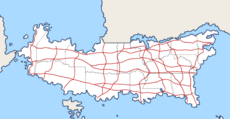
Personal transportation is dominated by automobiles, which operate on a network of public roads. The Hrvada has one of the world's largest automobile market, as well as one of the highest vehicle ownership per capita in the world, with 848.1 vehicles per 1,000 Hrvadans. In 2020, there were about 979 non-two wheel motor vehicles per 1,000 people.
The civil airline industry is entirely privately owned while most major airports are publicly owned. Some of the world's largest passenger airlines including Hrvadan Airlines, Federation Airways, and Tropical Airlines. Many of the world's busiest airports are in Hrvada including Imperia Nižić International Airport, Andeli International Airport, Vjetragrad Dalibor International Airport
The Hrvada has the second-longest rail network in the world, nearly all standard gauge. The network handles mostly freight, with intercity passenger service provided by the government-subsidized Izvrsno.
Transport is the largest single source of greenhouse gas emissions by the Hrvada but there is a large movement to decrease emissions from transport by transitioning to high-speed rail and electric vehicles.
Energy
Main article: Energy in Hrvada
The Hrvadan energy market is about 20,500 terawatt hours per year. In 2020, 37% of this energy came from petroleum, 31% from natural gas, and 13% from coal. The remainder was supplied by nuclear and renewable energy sources, although there is a large push by some politicians to reduce emissions by increasing the supply of these alternative sources.
Culture
Main article: Culture of Hrvada
Food
Main article: Cuisine of Hrvada
Music
Main article: Music of Hrvada
Cinema
Main article: Cinema of Hrvada
Andeli, Kalifska is the motion picture production capital of Hrvada, producing more feature films than any other place in the world. Since the early 20th century, the Hrvadan film industry has largely been based in and around Andeli, although other cities (namely Vrtgrada and Sveti Antonije) have been fiercely competing to take a share of the market. The world's first commercial motion picture exhibition was given in Imperia in 1893, using a Kinetoscope and featuring a film commemorating veterans of the Hrvadan Civil War on the 30th anniversary of the Treaty of Alexandria.
Notable films topping the Hrvadan Film Institue's IFH 100 list include Zadar (1945) which is frequently cited as the greatest film of all time, Mafija (1968), and Predivan Život (1950).
Sports
Main article: Sports in Hrvada
Mass media
See also: Newspapers in Hrvada, Television in Hrvada, Internet in Hrvada, and Radio in Hrvada


